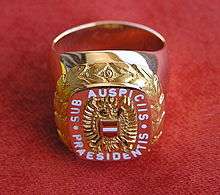Sub auspiciis Praesidentis
In Austria, the highest possible honor for achievement is the promotio sub auspiciis (prasidentis rei publicae). In this ceremony, the head of Austria honors the country's best students with a gold ring, engraved with the words "sub auspiciis praesidentis" and the emblem of Austria.

History
The history of the promotio sub auspiciis goes back to the 17th century, when the best philosophy students at the University in Vienna were invited to the Palace of the Holy Roman Emperor to receive gold medallions embossed with the Emperor's profile. This was a reward for their excellent achievements for their country.
In the following centuries, until the abolishment of the monarchy in 1918, this tradition became widespread and was coined "promotio sub imperatoris" (under the eye of the Emperor of Austria) for Universities in the Austrian part or "promotio sub regis" (under the eye of the King of Hungary) for universities in the Hungarian part of the Austro-Hungarian Empire.
After World War II, beginning in 1952, the term "sub auspiciis" was reintroduced with the addition of "praesidentis rei publicae" (under the eye of the President of the Republic).
Requirements
In order to qualify for this honor, an individual must be perceived to possess exemplary moral character and succeed in passing all requirements for a doctorate within a given time scale, and with the highest possible grades.[1]
Matura
In order to achieve the promotio sub auspiciis, one has to acquire "passed with distinction" already at high school: each year of high school, as well as the final exam Matura, have to be "passed with distinction".[1]
High school lasts four to five years (depending on the type of school), including both prescriptive and elective subjects. These subjects are individually graded as either
- (sehr gut; excellent),
- (gut; good),
- (befriedigend; satisfactory),
- (genügend; sufficient) or
- (nicht genügend; failed).
To get "passed with distinction", all subjects must, on average, have received grades 1.5 or better.
Finally, high school ends with the Matura, a formalized summative assessment which is graded as follows:
- "mit ausgezeichnetem Erfolg bestanden" (passed with distinction: an average of 1.5 or better, no grade below 2),
- "mit gutem Erfolg bestanden" (passed with merit: an average of 2.0 or better, no grade below 3),
- "bestanden" (passed: no grade below 4),
- and "nicht bestanden" (fail: at least one grade of 5).
Diploma or Bachelor/Master
In Austria a diploma curriculum is divided into several (usually two or three) parts. All parts end with diploma examinations. In order to make it possible to get the promotio sub auspiciis each grade in each of these diplomas has to be best possible (which usually is the grade 1). Moreover, the degree has to be completed within the average studying time.[1]
The requirements are the same for bachelor and master degrees: all grades have to be best possible.
Ph.D.
The Austrian doctoral degree depends on a Ph.D. thesis (Doktorarbeit) and an oral examination (Rigorosum). For the promotio sub auspiciis, both have to be rated with 1 and "passed with distinction" has to be given.[1]
Note that there are no Latin honors like in Germany associated with this degree.
Other
In Austria, approximately 20 out of 2500 students graduate as "sub auspiciis" per year, resulting in just 1042 of such graduations between 1952 and 2012.[2] The Austrian Botanist Eva Schönbeck-Temesy graduated sub auspiciis in 1954 and the Austrian Astrophysicist Lisa Kaltenegger in 2005.
Literature
- Walter Brunner, Die Promotio sub auspiciis, Wien : Bundesministerium für Wissenschaft und Forschung 1990 ISBN 3-85456-231-4
- Gabor Hamza - Istvan Hoffman, "History and Current Situation of the Promotio sub auspiciis Praesidentis Rei publicae in the Hungarian and Austrian Legal Education", Magyar Tudomány 59 (2014) S. 849-853.
References
External links
| Wikimedia Commons has media related to Promotio sub auspiciis Praesidentis rei publicae. |
- Bundesgesetz über die Verleihung des Doktorates unter den Auspizien des Bundespräsidenten (Rechtsgrundlage)
- bmwf.gv.at